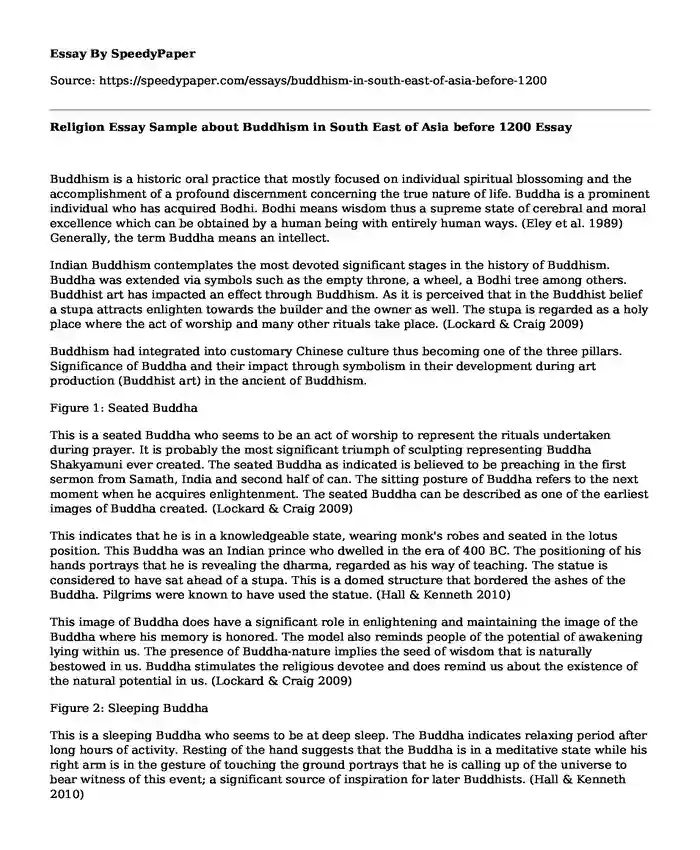Buddhism is a historic oral practice that mostly focused on individual spiritual blossoming and the accomplishment of a profound discernment concerning the true nature of life. Buddha is a prominent individual who has acquired Bodhi. Bodhi means wisdom thus a supreme state of cerebral and moral excellence which can be obtained by a human being with entirely human ways. (Eley et al. 1989) Generally, the term Buddha means an intellect.
Indian Buddhism contemplates the most devoted significant stages in the history of Buddhism. Buddha was extended via symbols such as the empty throne, a wheel, a Bodhi tree among others. Buddhist art has impacted an effect through Buddhism. As it is perceived that in the Buddhist belief a stupa attracts enlighten towards the builder and the owner as well. The stupa is regarded as a holy place where the act of worship and many other rituals take place. (Lockard & Craig 2009)
Buddhism had integrated into customary Chinese culture thus becoming one of the three pillars. Significance of Buddha and their impact through symbolism in their development during art production (Buddhist art) in the ancient of Buddhism.
Figure 1: Seated Buddha
This is a seated Buddha who seems to be an act of worship to represent the rituals undertaken during prayer. It is probably the most significant triumph of sculpting representing Buddha Shakyamuni ever created. The seated Buddha as indicated is believed to be preaching in the first sermon from Samath, India and second half of can. The sitting posture of Buddha refers to the next moment when he acquires enlightenment. The seated Buddha can be described as one of the earliest images of Buddha created. (Lockard & Craig 2009)
This indicates that he is in a knowledgeable state, wearing monk's robes and seated in the lotus position. This Buddha was an Indian prince who dwelled in the era of 400 BC. The positioning of his hands portrays that he is revealing the dharma, regarded as his way of teaching. The statue is considered to have sat ahead of a stupa. This is a domed structure that bordered the ashes of the Buddha. Pilgrims were known to have used the statue. (Hall & Kenneth 2010)
This image of Buddha does have a significant role in enlightening and maintaining the image of the Buddha where his memory is honored. The model also reminds people of the potential of awakening lying within us. The presence of Buddha-nature implies the seed of wisdom that is naturally bestowed in us. Buddha stimulates the religious devotee and does remind us about the existence of the natural potential in us. (Lockard & Craig 2009)
Figure 2: Sleeping Buddha
This is a sleeping Buddha who seems to be at deep sleep. The Buddha indicates relaxing period after long hours of activity. Resting of the hand suggests that the Buddha is in a meditative state while his right arm is in the gesture of touching the ground portrays that he is calling up of the universe to bear witness of this event; a significant source of inspiration for later Buddhists. (Hall & Kenneth 2010)
The iconographic Buddhism do represent the ancient Buddha in his last illness that was yet to start up the Parinirvana - by the Buddha lying on his right-hand side and his head resting and relying on his right arm to support his head. With the persistence of the illness, the Buddha died, and his followers thought it wise to build a statue of his last moments while lying down.
Figure 3: Buddhist pilgrimage site
Buddhist pilgrimage sites. The most significant places of pilgrimage associated with Buddha were located in the plains of Northern India and southern Nepal (Eley et al. 1989). The development of this Buddha was due to anticipation that probably had been initiated by the appearance of impressive sculpts Buddha's in the shrine of cave 4 and cave 7. (Lockard & Craig 2009) This motivated the followers to make the Buddha such that the presence of pilgrimage site would be felt by purposing to visit these sites.
The significance of the Buddha in pilgrimage is to endorse a spiritual discipline in regard of fulfilling a vow. It also does facilitate an expression of feelings of devotion such that a healthy relationship is established in connection with the pilgrimage site.
In conclusion, there are different kinds of Buddha which represented different meaning. Each Buddha was perceived to accomplish its purpose in the Buddhism religion. Buddha is believed to bring good luck or even encourage followers when disappointed.
Works Cited
Eley, Geoff, Sherry B. Ortner, and Nicholas Dirks. Great religion: A cultural and political history of Sherpa Buddhism. Princeton University Press, 1989.
Hall, Kenneth R. A history of early Southeast Asia: Maritime trade and societal development, 100-1500. Rowman & Littlefield Publishers, 2010.
Lockard, Craig. Southeast Asia in world history. OUP USA, 2009.
Cite this page
Religion Essay Sample about Buddhism in South East of Asia before 1200. (2022, Feb 24). Retrieved from https://speedypaper.net/essays/buddhism-in-south-east-of-asia-before-1200
Request Removal
If you are the original author of this essay and no longer wish to have it published on the SpeedyPaper website, please click below to request its removal:
- The Two Keys to Success in Education, Essay Example
- Free Essay on Elbow Pain Case Study - Diagnosis and Treatment
- Nursing Essay Sample: Interaction Technique Analysis
- Free Essay on the Differences Between Police Department in Cincinnati and Boston
- Why More People Love to Do Face Surgery. Essay Example.
- Essay Example about Media Mandates and Media Regulations
- Behavioural Health Services for Bipolar Disorder, Essay Sample
Popular categories





